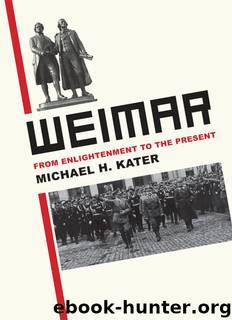Weimar by Michael H. Kater

Author:Michael H. Kater
Language: eng
Format: epub
ISBN: 9780300170566
Publisher: Yale University Press
CHAPTER 8
Buchenwald
1937 to 1945
AT THE BEGINNING OF 1938 THE FORMER BAUHAUS STUDENT FRANZ Ehrlich was busy with an important project. He was designing a slogan in large letters later to be worked into a meters-high iron arch. The inscription was to read: JEDEM DAS SEINE, or To Each His Due. Later in 1938, after finishing in a metal shop, this cynical motto was fixed in iron latticework high above the main entrance of the concentration camp of Buchenwald.
Most certainly, this was a belated Bauhaus product the school's founder Walter Gropius would never have been able to imagine. No greater contrast could have been construed for the Germany of the 1920s and '30s: individualistic design by the artistic avant-garde on the one side, and brutal fascistic oppression on the other. So how did Ehrlich manage to move between two such extremes? He was born in 1907 in a Leipzig suburb as the son of a mechanic. After training as a cast-and-die maker he became a machinist and eventually a mechanical engineer. Having visited the famous Bauhaus exhibition in nearby Weimar in 1923, he decided, four years later, to enroll. From 1927 to 1930, he attended the Dessau Bauhaus, studying chiefly under Klee, Kandinsky, Moholy-Nagy, and Schlemmer. He learned Bauhaus-style design work, which would later characterize his Buchenwald lettering, under graphic design teacher Joost Schmidt. In 1930, he received his Bauhaus diploma.
Politically sensitized from the days of his youth, he became the student representative in the Bauhaus Masters' council. Since 1927, he had been a member of the German Communist youth movement, joining the KPD in 1930. Hitler's assumption of power in 1933 drove him into the Communist resistance, and in 1935 he was arrested, tried for conspiracy to commit high treason and sentenced to three years in penitentiary. He had spent two years in the prisons of Waldheim and Zwickau when the SS came for him in 1937 and carted him off to the Buchenwald camp, which was in the process of construction. There he toiled in the quarry, as a carpenter, and in the building unit. He was forced to draw up what was to become Buchenwald's signature sign. Until his release in 1939 Ehrlich was active in the Communist camp resistance. Thereafter, during the war, he was assigned to the infamous punitive battalion 999 but miraculously survived the front. After 1945, still a loyal Communist, he involved himself in the development of the German Democratic Republic (GDR).
Ehrlich was designing the entrance sign because the SS had forced the first inmates of Buchenwald to construct the camp virtually on their own. He was working alongside fellow inmates, but not necessarily those from Germany's very first concentration camp, Nohra, less than four miles from Weimar, although possibly some prisoners from Nohra, which was already closed, were his cell mates. Opened on March 3, 1933, Nohra had reached its maximum number of 220 prisoners, all Communists, around March 12, after transfer from Thuringian police and SA holding stations. How many inmates Nohra
Download
This site does not store any files on its server. We only index and link to content provided by other sites. Please contact the content providers to delete copyright contents if any and email us, we'll remove relevant links or contents immediately.
The Art of Boudoir Photography: How to Create Stunning Photographs of Women by Christa Meola(18537)
Red Sparrow by Jason Matthews(5390)
Harry Potter 02 & The Chamber Of Secrets (Illustrated) by J.K. Rowling(3620)
In a Sunburned Country by Bill Bryson(3481)
Drawing Cutting Edge Anatomy by Christopher Hart(3454)
Figure Drawing for Artists by Steve Huston(3381)
Harry Potter and the Prisoner of Azkaban (Book 3) by J. K. Rowling(3304)
The Daily Stoic by Holiday Ryan & Hanselman Stephen(3233)
Japanese Design by Patricia J. Graham(3109)
The Roots of Romanticism (Second Edition) by Berlin Isaiah Hardy Henry Gray John(2878)
Make Comics Like the Pros by Greg Pak(2852)
Stacked Decks by The Rotenberg Collection(2811)
Draw-A-Saurus by James Silvani(2655)
Harry Potter and the Deathly Hallows (7) by J.K. Rowling(2641)
Tattoo Art by Doralba Picerno(2600)
On Photography by Susan Sontag(2575)
Churchill by Paul Johnson(2506)
The Daily Stoic by Ryan Holiday & Stephen Hanselman(2459)
Drawing and Painting Birds by Tim Wootton(2438)
